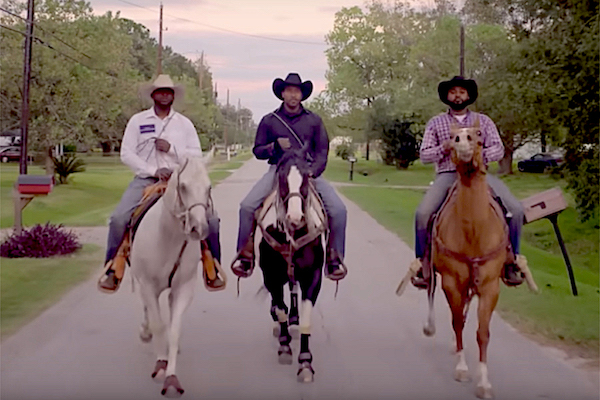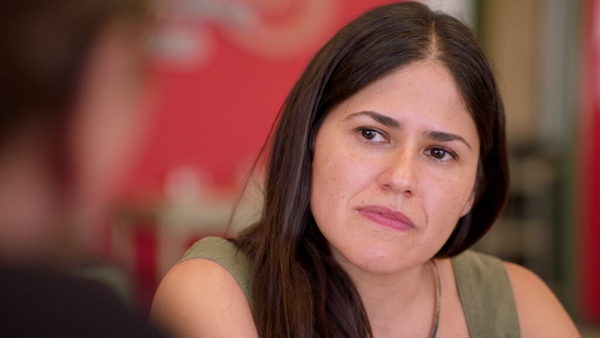Film Reviews: April’s Streaming Docs
By Neil Giordano
A selection of notable documentaries currently in the digital universe: Christian missionaries, high school athletics, and a trio of filmmakers who mess with Texas.

A scene drawing on animation in The Mission.
A familiar story — a young man on a quixotic quest that ends in tragedy — takes a new turn in National Geographic’s The Mission (Hulu, Disney+), a variation on Into the Wild that takes a godly twist. North Sentinel Island, perhaps the most isolated place left on earth, is populated by an indigenous tribe that shuns all contact with the rest of humanity. They are protected by the Indian government from any and all invaders who try to venture there. In 2018, however, 23-year-old missionary John Allen Chau did just that…and was killed when he attempted to bring Christianity to the North Sentinelese. This Oscar-shortlisted film uses a variety of documentary approaches, some of them instructive and novel, including archival social media and interviews with missionaries who are no longer in the field. Some of its strategies, however, are a bit forced, such as cheesy animated reenactments. All of these perspectives are used to explain how the charismatic and photogenic Chau ended up dead on the beach, his dream extinguished.
The illegality of Chau’s quest was no hindrance to him or his sometimes unnamed collaborators. The film underlines the passion and blind idealism of youth as well as the decidedly male instinct toward danger and self-sacrifice in service of higher ideals. It also throws some uncritical light on the world of young Christian missionaries (in this case from Oral Roberts University, where Chau attended). These do-gooders are fortified with faith and hellfire to venture out into the world, determined to proselytize and convert those who are in need of the word of God. The film is at its most effective when it investigates the history of colonialism, particularly the experience of Western interlopers in “uncivilized” places. Archival footage and clips from feature films show the romance of risking all for God’s glory — a narrative that omits the long history of exploitation, racism, and outright violence. In a bite-the-hand-that feeds-you aside, the movie even implicates the paradoxes inherent in a branch of the documentary tradition that has been practiced, for decades, by National Geographic itself, showing how these films champion the “othering” of non-white, non-industrialized cultures.

A scene from B.S. High.
A different type of exploitation is given a well-deserved raking over the coals in B.S. High (Max), a takedown of the commercialization of American high school sports. The documentary doubles as an entertaining portrait of a conman — its protagonist or maybe antagonist (?), Roy Johnson — head football coach of Bishop Sycamore High School. The title is a play on the name, since Bishop Sycamore was nothing but a scam. Drawing on the name of a fictitious school, Johnson created a ragtag football program that could compete nationally against better known and more talented teams, many of whom had lucrative ESPN contracts. The coach sugared over his massive ego and venal aims with the altruistic language of “giving Black kids a chance at life.” His agreement to be profiled for the movie falls apart as his shell game is exposed, piece by piece, by the filmmakers. Along the way, we are tiven the real story underneath the drama; the plight of young Black men looking for opportunity through athletics. One player rides the Bishop Sycamore gimmick all the way to recruitment by a big-time college, only to see his dreams fall apart when the ruse becomes a national story in 2021. As seen in powerful achievements like Hoop Dreams (a more multifaceted film), the lives of the boys are at the mercy of people like Johnson, whose selfishness sadly trumps their aspirations.

A scene from God Save Texas.
High school football receives a cameo in God Save Texas (Max) but, thankfully, this 3-part docuseries delves into more crucial topics about Texas, and by extension, America at large. The series is a spiritual successor to the work of award-winning journalist Lawrence Wright, whose eponymous 2018 book examined Texan culture, history, and politics. (Wright appears in each episode as a sounding board.). Each of the three feature-length episodes are directed separately by Texas filmmakers; the second and third episodes are especially noteworthy because of their nuance and craft .
In “The Price of Oil,” Alex Stapleton (director of last year’s excellent Reggie Jackson doc) explores environmental justice in the shadow of the state’s infamous oil industry. Looking into her own family’s history in Houston and Port Arthur, she reveals how Black residents have borne the brunt of the industry’s polluting ways while reaping few of its economic benefits, from jobs to home ownership. Tracing her family roots back to slavery, the film’s through-line is an examination of exploitation and marginalization. Stapleton’s family’s neighborhood, aptly named Pleasantville, was historically a comfortable harbor for middle-class Blacks in an economy that kept de facto segregation alive through redlining and so-called “fence communities”: areas where the oil and petrochemical industries would build refineries and infrastructure right up to the fence line of the houses.

Iliana Sosa in God Save Texas.
Iliana Sosa’s third installment, “La Frontera,” explores the bicultural experience of her Mexican-American family in El Paso and Juarez, two urban centers that amount to “one big city” despite massive inequities in wealth and safety. Sosa’s grandfather lives on both sides of the border, and her mother, now a U.S. citizen, travels between the two, living the life of a fronteriza, as does Sosa herself. It should not be surprising that the reality of immigration in the region is much more complicated than how facile political schemes like border walls would have it. Instead, the film charts an ongoing culture war between the northern side of the border in Texas and Washington DC.
The first episode, “Hometown Prison,” helmed by marquee-name Richard Linklater, is the weakest of the three, because the director expends a little too much dude-bro energy on his non-specific autobiographical memories of growing up in Huntsville, Texas. Still, to Linklater’s credit, the focus eventually turns to Huntsville’s reputation as Prison Town USA, home to nine correctional facilities including Texas’s infamous death row. The result is that capital punishment and the prison industrial complex are viewed as distinctly homegrown phenomena, revelatory of the racial history of incarceration and the plantation system in Texas. The series as a whole poses important questions about the evolution — and devolution — of American values
Neil Giordano teaches film and creative writing in Newton. His work as an editor, writer, and photographer has appeared in Harper’s, Newsday, Literal Mind, and other publications. Giordano previously was on the original editorial staff of DoubleTake magazine and taught at the Center for Documentary Studies at Duke University.
Tagged: "B.S. High", "God Save Texas", "The Mission", "The Price of Oil", Alex Stapleton
